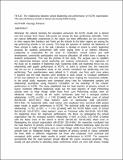| dc.identifier.citation | Muguna, M. S., Gichohi, P. M. & Kibaara, T. (2021). Assessment of School-Based Clinic as a Health Service Provision Model in Public Secondary Schools in Meru County, Kenya. Journal of Education, 4(3), 105-119. | en_US |
| dc.description.abstract | The Government of Kenya has made an effort in facilitating access to healthcare by students through the development of a standard manual on safety and health in schools and introducing a unique NHIF program for students in public secondary schools. However, the same has been marred by the lack of sustainable mechanisms, systems and structures. This state of affairs attests to the absence of a profound model for addressing the healthcare needs of students in public secondary schools in Kenya. This study assessed the school-based clinic as a health service provision model in public secondary schools in Meru County, Kenya. The specific objective was to examine the efficacy of school-based health clinics in addressing students' healthcare needs in public secondary schools in Meru County. Andersen's model of health service utilization was significant in guiding this study. The study utilized a descriptive survey design. Schools were stratified according to categories, and then, a proportionate systematic sampling technique was used to sample 191 principals and 195 Chairpersons of the Students' Council. At the same time, the County Director of Education was purposively selected. Data was collected using a self-administered questionnaire and interview guide. The collected data were analyzed using SPSS, where factor analysis, means and standard deviations were computed. Linear regression analysis was used to test the hypothesis. Qualitative data were analyzed using the thematic technique. The majority of public secondary schools did not have a school-based health clinic. Where available, they were underutilized, poorly equipped, lacked trained health professionals, had poor infrastructures and were derailed by the lack of funding. Despite these challenges, SBHCs were statistically significant in addressing students' healthcare in public secondary schools. The study recommended that the Ministry of Education develop mechanisms and policy frameworks for establishing school-based health clinics in public secondary schools. It should also carry out capacity building programs for principals to equip them with skills for managing the SBHC facility and writing grants proposals. In addition, principals should exercise prudent management practices, ensure quality assurance of SBHCs, and pursue a concerted effort, collaborations, and partnerships of stakeholders in establishing and running school-based health clinics in public secondary schools. | en_US |




